QUAD 33 Preamp And 303 Power Amp Review
And yet it moves me! Nearly 50 years after the unsettling encounter with the 1967 original, the retro-reincarnation of these Quad legends generates pure excitement. This is not a test, but a journey through time!
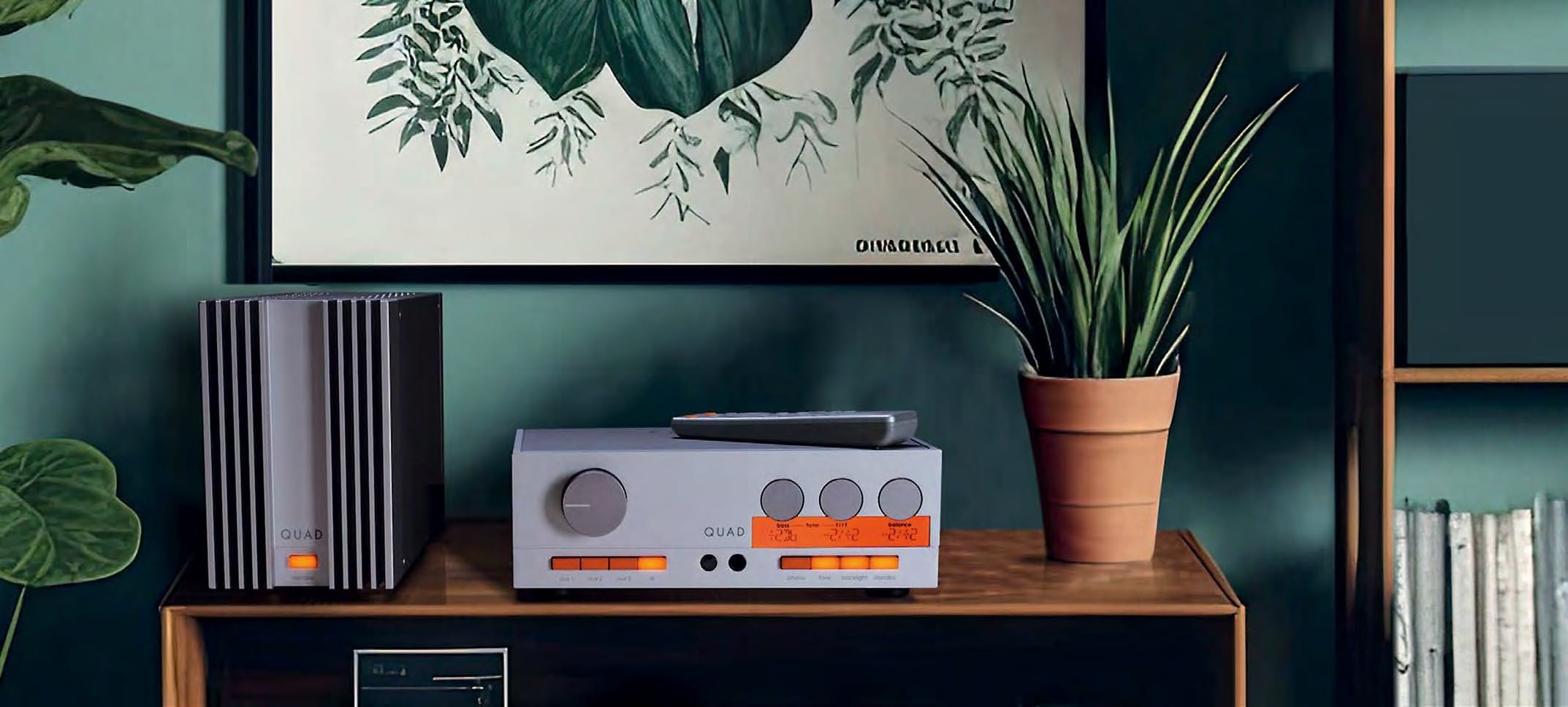
What I recently set up in the listening room with great anticipation is not only far off the usual track. It was also the second trip through time within just a few weeks. And it took me even farther back into my own hi-fi history than my encounter with the Naim components in the last issue. Much farther! The Quad 33 and the Quad 303 beamed me back to the days of my confirmation hi-fi. I had not owned my classy-looking Marantz receiver for very long and was pretty happy with it. But at some point, a classmate showed me her father’s stereo system. She said he was also a hi-fi enthusiast, and these devices from England were his pride and joy. Since he drove an Alfa Romeo Giulia, he clearly had a special kind of taste.
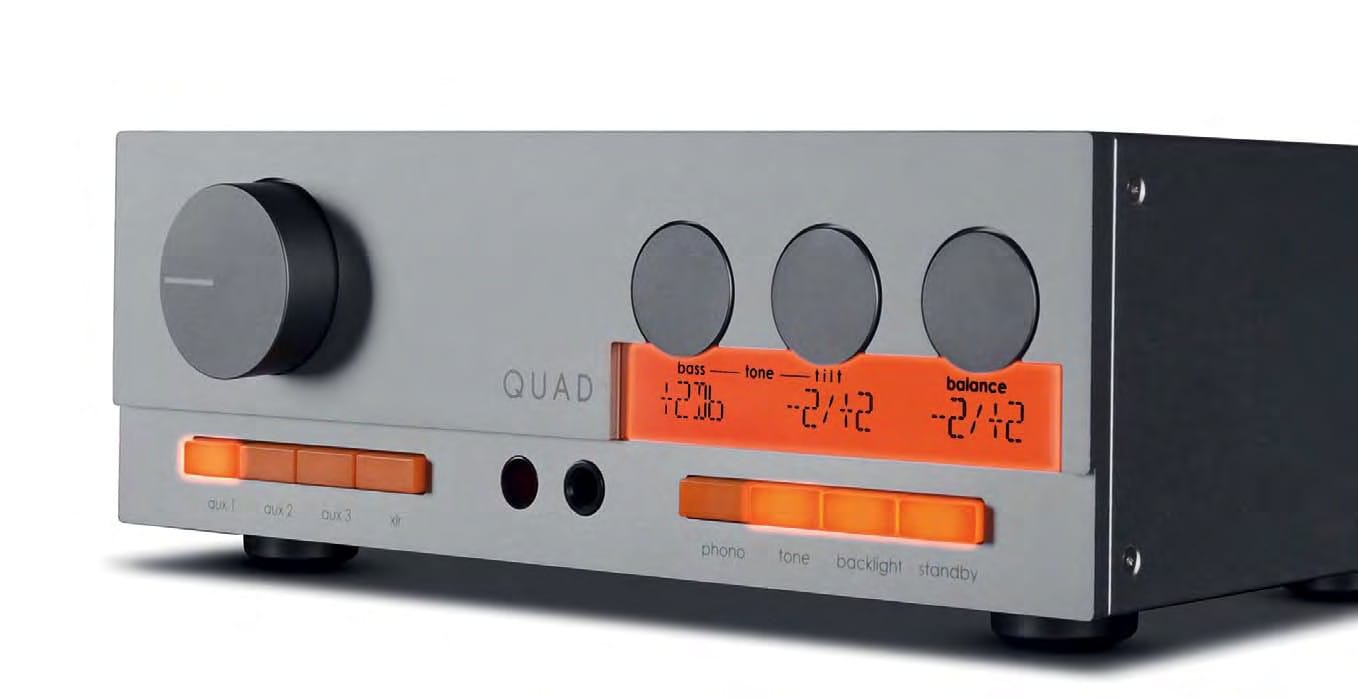
When I, full of anticipation for a “super system” as we knew them back then, saw a collection of small, mouse-gray boxes in a quirky design with plastic knobs, I was pretty startled. To make matters worse, the turntable was humming—back then, along with tape and tuner, it was the most important and also the best-sounding source. As perplexed as I was, I didn’t blame that hum on a simple grounding issue; I blamed it on these strange devices that reminded me of DIY kits from an electronics hobby shop. How was I supposed to know Quad? The brand from Cambridgeshire wasn’t sold in any typical store, and 7Review hadn’t been invented yet. My conclusion at the time was right out of an Asterix comic: “These Brits must be crazy!”
Back to the future: Here I am now and can’t help but give the reincarnation of the old Quad spirit the utmost respect. A lot has happened since then—not just with Quad Electronics, which now belongs to the IAG empire. And I’m sitting in the editorial office, right at the source, ready to put these new and exciting components to the test. In short: the opportunity for a fresh start with Peter J. Walker’s cult brand, founded in London in 1936. There’s no arguing about taste, but after decades of living with inconspicuous boxes from Mission and Naim, I find the retro design of the 33 and 303 really sharp. But the real pioneer in the classic originals was mainly the
Back to the future: The hi-fi heroes from Quad were revived with modern technology.
circuitry. With their pre/power combo in the second half of the ’60s, Quad was one of the first manufacturers to switch from tube amps to transistor amps. Equally forward-thinking was their departure from integrated amplifiers. In their eagerness, the Brits separated components that at the time seemed as inseparable as the European Union does today. But splitting the preamp and power amp really did bring an improvement.
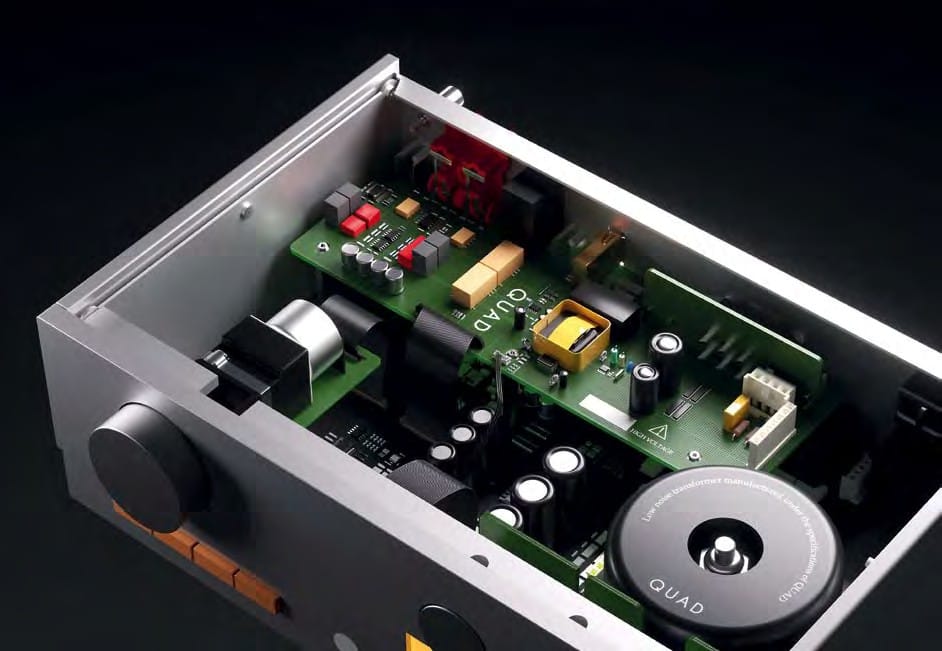
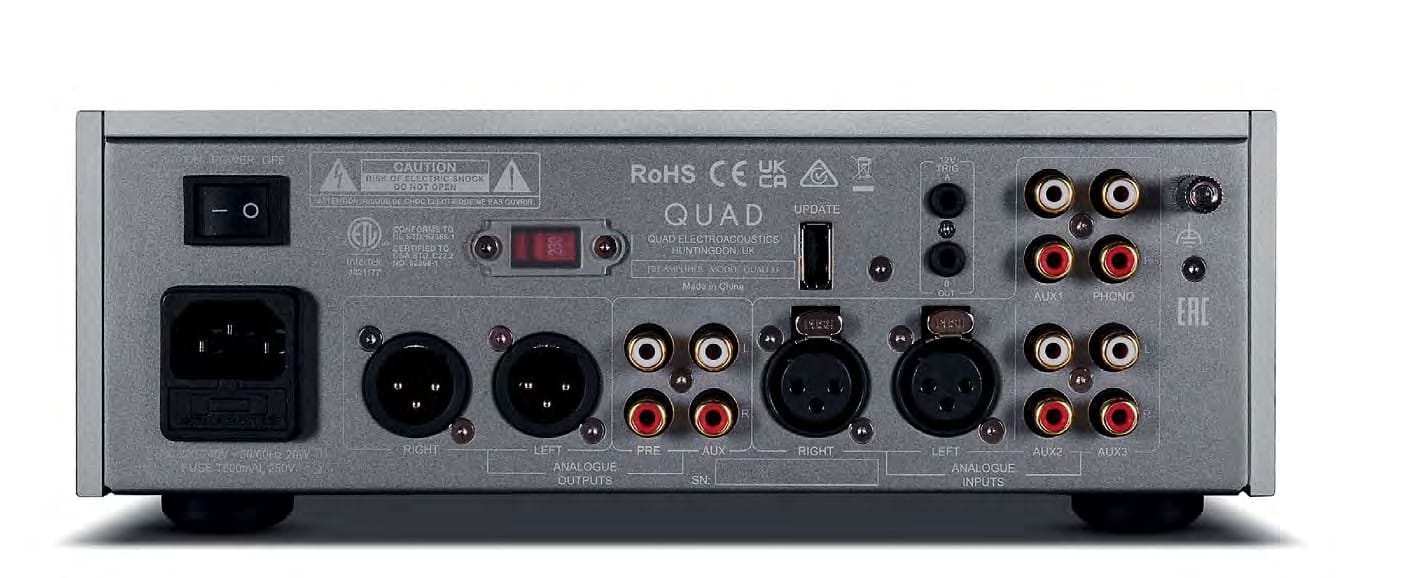
However, having a horizontal preamp and a vertical power amp offers not only a few aha moments but also some disadvantages: you can’t really stack them in a normal hi-fi rack. But why would you hide such eye-catchers anyway? Their different formats also convey a hidden message. Here’s a hint: On the back of the massive aluminum case of the 303, right next to the RCA and XLR inputs, there’s a tiny button that puts the power amplifier into bridge mode. This doesn’t just provide double the output power for taming something that’s hard to drive. You also need a second power amp for this and, at around 12 cm width each, they end up matching the preamp’s width of 23.8 cm—so stacking them suddenly looks much more harmonious.
Even if, like me, you haven’t developed a fondness over the years for that quirky Britishness that combines solid aluminum with orange-illuminated plastic buttons, you’ll definitely be impressed after lifting these two devices: they may appear lightweight, but they’re heavier than many full-size components made of thin sheet metal. That’s especially noteworthy because their understated appearance might initially suggest the opposite.
Quad 33 Performance Report
Broadband, dead-straight line-frequency response (red), Phono MM/MC (green/blue) with slight rumble filtering. Distortion spectrum in line with 1 kHz tone and 0.5 V: very low noise floor, minimal distortion residues, THD+N 0.001%. No gain on line signals (control range -80…0 dB), which is no issue given the high input sensitivity of the power amp (0.7/1.5 V RCA/XLR). MM stage: Gain 46 dB; input impedance 47 kΩ/90 pF; SNR 84/69 dB (1 kΩ load/standard system). Exceptionally low-noise MC stage: Gain 62 dB; SNR 77 dB; input impedance 120 Ω; universal headphone amp: output impedance 3 Ω; gain 8 dB; voltage at 32/300 Ω: 4.1/4.8 V (500/80 mW). Power consumption standby/operating: 0.5/8 W.
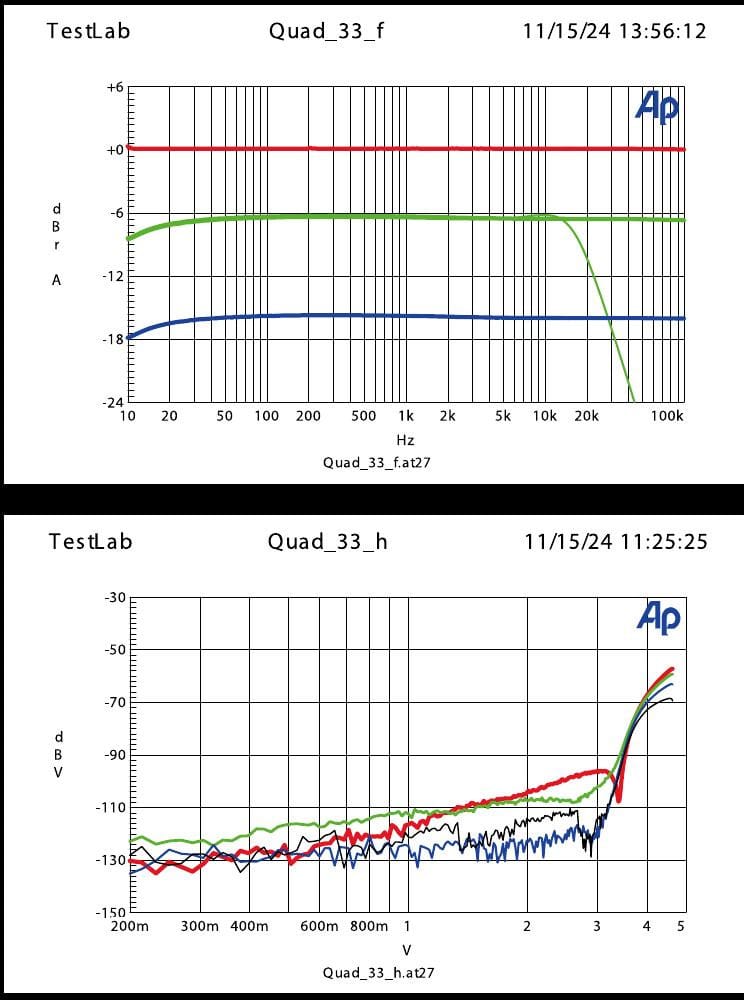
Shockwork Orange
The price is also surprising once you’ve gotten your hands on them: each of them costs $1,600. This really seems fair given their level of engineering, especially since Quad doesn’t even try to disguise plastic as metal in the buttons, instead proudly presenting orange as a striking contrast to the mainstream. Chapeau, as the English might say—assuming they lived in the 1st century after the Norman conquest. After all, French was the official administrative language back then. If only Asterix had known!
Back to the descendants of those hi-fi components that were built for 18 years and shaped the entire scene. The layout follows the typically British purist approach for the shortest signal paths, and the toroidal transformers in both preamp and power amp would impress even the most conventional hi-fi fans. Connectivity is on par with devices twice the size and price. You can connect the preamp and power amp using balanced cables, and there’s also one balanced input for a source. There’s not only a phono input, but you can press the phono button multiple times to switch between MM and MC.
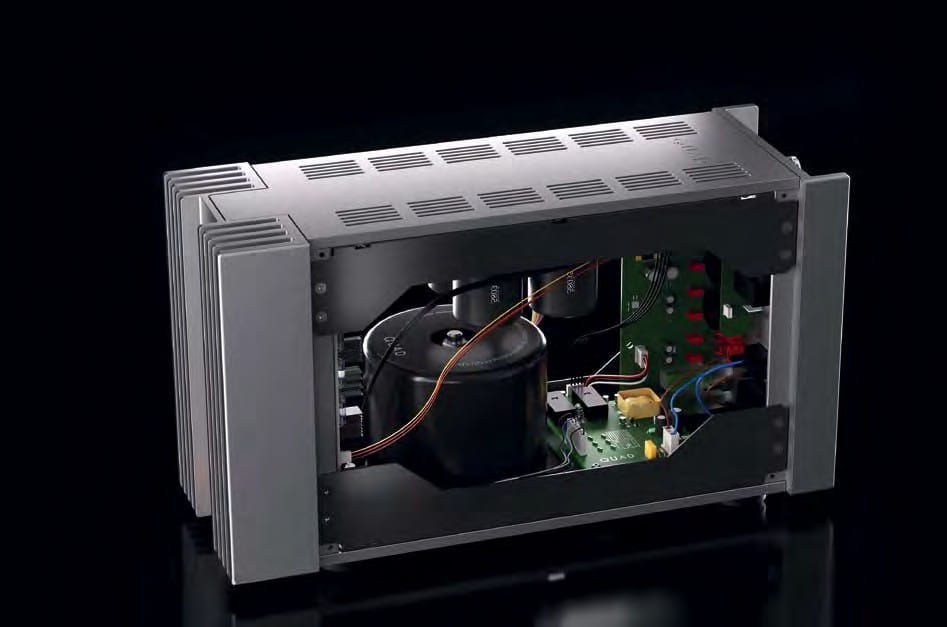
Quads Up in Terms of Sound?
To keep the suspense, I started my listening test with the high-level inputs. Wow, these Brits can swing! After a short warm-up period, the 33 and 303 rendered the contours of singers and instruments with increasing clarity. On a wide soundstage, they placed each sound with Sherlock Holmes-like precision—sorry, old school—while delivering extremely natural timbres.
What was impressive was the absence of any hardness, without sugarcoating anything. It bordered on magical. When listening to the piano on a CD I recently bought after a concert at the Bix jazz club, you could sometimes even hear the mechanical action. The bass drum had punch and precision, and the brush strokes on the cymbals were very well-defined and
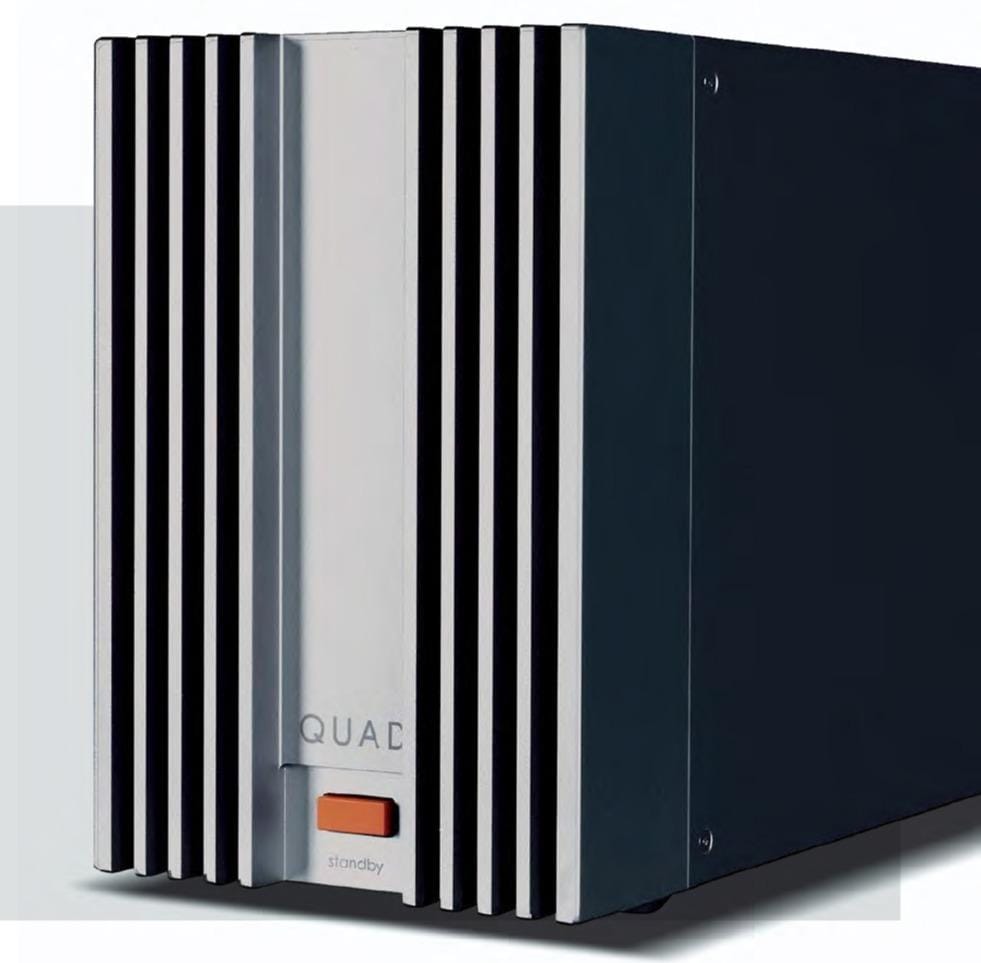
In mono mode, the 303 delivers more than double the power. With the additional amp required for this, the total width matches that of the 33.
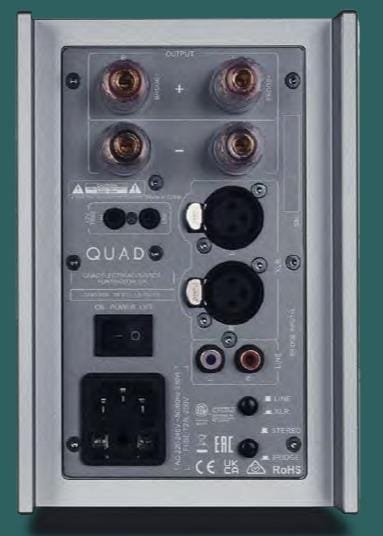
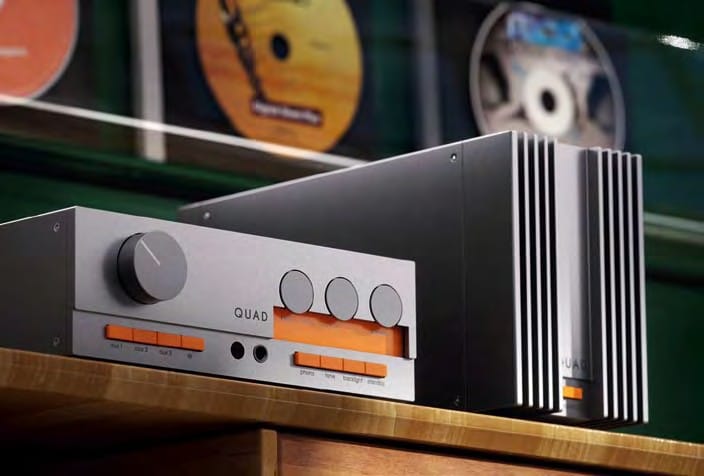
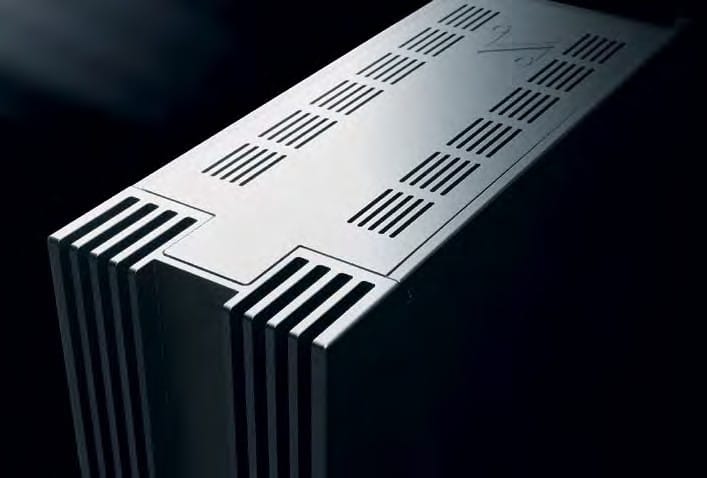
truly authentic. I was particularly excited by the phono path. Imagine that late at night, you still have 240 kilometers to drive from the editorial office to get a hot meal at the Italian place around the corner. And what do you do? You rummage through the editorial office’s record library, one LP after another, even though your verdict was already made after a few tracks from Pink Floyd’s “Wish You Were Here” and “Dire Straits” by the band of the same name. But after hearing Mark Knopfler’s insanely fast and precise guitar riffs and the punchy, tight drums on “Six Blade Knife,” I was sold. I immediately started downloading this album (which I hadn’t listened to in over ten years) on Qobuz, so I could enjoy it on my empty A8 journey home. I just couldn’t get enough.
Quad 303 Performance Report
Straight, load-independent, and wideband frequency response, measured at 8, 4, and 2 Ω load. Distortion components vs. power: very low distortion; k2 (red) is the relatively strongest distortion component; THD+N at 1 W: 0.005%. Signal-to-noise ratio RCA/XLR at 10 V: 108/103 dB, or bridged 101/97 dB. Gain RCA/XLR (fixed): 29/23 dB (bridged mode adds 6 dB). Power output per channel: sinusoidal at 8/4 Ω 48/70 W, bridged 165 W into 4 Ω. Complex music power at 8/4/2 Ω: 53/85/108 W. Power consumption in standby 0.2 W; operating 14 W; maximum 262 W (stereo) or 400 W (bridged).

CONCLUSION:
Love at second sight, one could say. The reincarnation of these 1960s hi-fi heroes radiates British understatement. And it sounds truly exhilarating, especially when considering its affordable price. This is precisely the kind of hi-fi gear you’d recommend to your best friends.
1960s ICON REIMAGINED! Quad 33/303 Amplifier Review
The original Quad 33/303 was one to the most prized amplifiers in the history of HiFi. Quad has reimagined it for 2024. How much ...



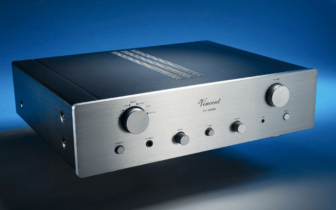
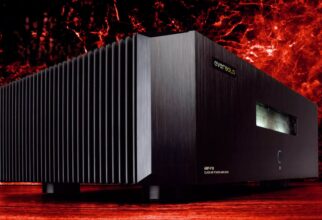
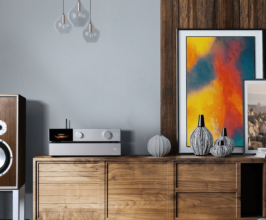
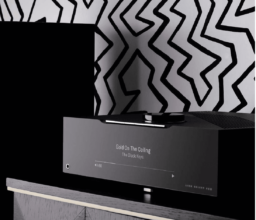
Great review, but has the 33 definitely got two headphone sockets?
I thought that one was the IR receiver for the remote.
the new quad 33 has one headphone socket – i know, i just received mine – did you actually have this product for review?
The original review source mentioned that it has two headphone jacks. I just checked the brand’s product page, and it only has one jack. Thanks for the information!